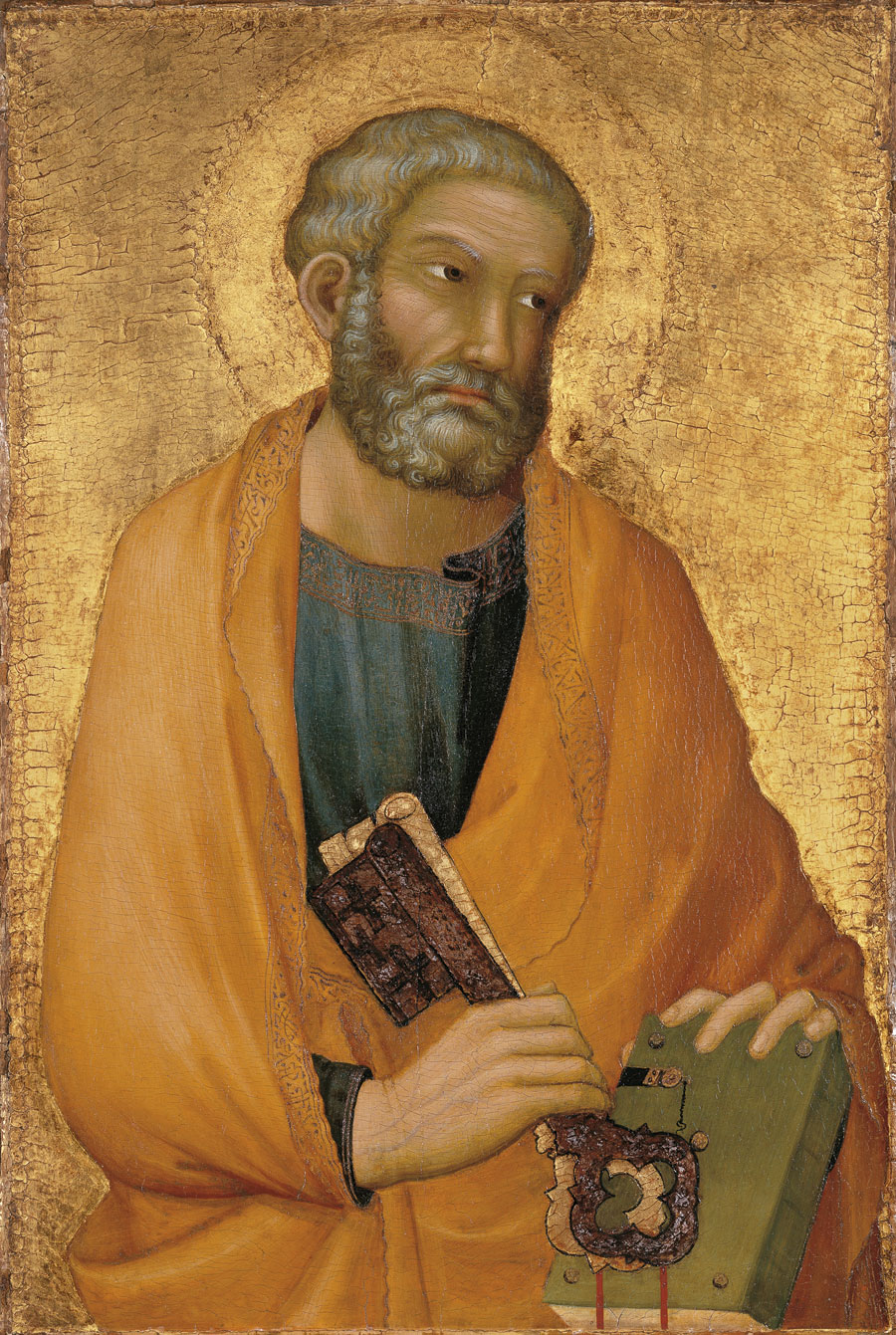Faith and Fervour in the Carmen Thyssen Collection. Simone Martini, Van Dyck, Gauguin
23 March - 30 June 2013
St. Peter, ca. 1326
Oil on panel, 58 x 38.5 cm Carmen Thyssen-Bornemisza Collection on deposit at Museo Thyssen-BornemiszaAs is required by an iconographic tradition without exceptions, St. Peter is represented as an old man holding the two keys, one silver and one gold, with which the prince of the Apostles opens and closes the gate of paradise. The position of the figure and the size of the panel, whose format has not suffered any alterations in the course of time, show that the work was originally part of a set composed by other elements. Apart from the one analysed here, it included on the left the figure of Saint Ansano, the protector of the city of Siena, at the centre the Virgin with Child and on the right the figures of Saint Andrew and of Saint Luke. The five panels composed a polyptych of a rather unsual shape, with the central panel of the same size as the side panels, and with each element independently framed. The box frames enclosing the various painted panels are in fact original, although their authenticity has often been questioned due perhaps to the restorations they have undergone. Each panel also had the name of the saint represented inscribed on the gilded background, as can still be seen in the Saint Luke from the Getty Collection; this piece also has the back painted in marble imitation, which may suggest that originally the polyptych was meant to be transported.
The history of this group of paintings was progressively reconstructed throughout the 20th century: today it is possible to identify in the dismembered altarpiece, the "very good panel" by Simone Martini which the Florentine sculptor Lorenzo Ghiberti saw before 1455 inside the Palazzo Pubblico in Siena. As Keith Christiansen demonstrated in a fascinating study, the work is probably the same for which the painter was paid in 1326: it was executed for the residence of the Capitano del Popolo and only later -after 1405-was placed on the altar of the sumptuous Cappella dei Signori on the first floor of the Palazzo Pubblico in Siena, next to the famous Sala del Mappamondo. Shortly afterwards the polyptych must have shown signs of decay as in 1448 the Signori set up a commission of three experts to establish the state of conservation of the altarpiece, and if necessary consolidate it and estimate the cost of the operation. The "restoration" was entrusted to the carpenter Giovanni di Vicho di Magno and to the painter Sano di Pietro, who enriched the original structure with the creation of a dais and a wooden canopy, and inserted the 14th-century panels in a complexly sculpted and inlaid frame inspired on the stalls executed by Domenico di Niccoló dei Cori for the same chapel between 1415 and 1428 and still kept in their original location. In order to complete the
altarpiece, Sano di Pietro also painted five panels with Stories from the Life of the Virgin, which were placed as a predella below each of the panels by Simone Martini; the quality of the materials used and the cost of the work show the high consideration in which the generally conservative political authorities of Siena held the work of an artist from the past who was considered in the 15th century, together with Giotto and the Lorenzetti brothers, as one of the founders of modern painting.
The altarpiece of the Cappella dei Signori was disassembled in 1686 and substituted by the altarpiece from the Cathedral painted by Sodoma around 1535, which can still be seen in its new location. Documents regarding the elements of the disassembled polyptych can be found in Siena until the end of the 18th century; after that date the work seems to have vanished into thin air until the beginning of the 20th century, when the various fragments reappeared on the antiques market in different places, and generally under the name of Lippo Vanni. The attribution to Simone Martini, initially suggested by Oswald Sirén and taken up by Raymond van Marle, was later sustained by Miklós Boskovits and today is unanimously accepted.
In spite of the unsatisfactory state of conservation of the gilded background and of the aureole (the pattern made up of segmented arches developed along the edges of the panel is still intact) the panel with St. Peter reveals the unmistakable personality of Simone Martini who, in this composition, associated a motif inspired on ancient sculpture-the attitude of the right arm of the saint-and the extraordinarily modern invention of the book resting on the edge of the frame, which creates a sense of depth. A similar chromatic range appears in the fragmented polyptych kept in the Museo dell'Opera del Duomo in Orvieto where an image of St. Peter similar to the one analysed here is depicted. Some deeper lines and the superficial execution of certain details like the hands of the saint indicate that, like in other panels of the same series, the master worked with a close collaborator who may have taken part in the painting of the altarpiece with The Blessed Agostino Novello and Four of his Miracles. The stylistic closeness of this panel, executed around 1325-1328, confirms that the execution of Saint Peter and of the paintings associated with it dates from the same period, shortly before Simone Martini's departure for Avignon.
Mauro Natale
